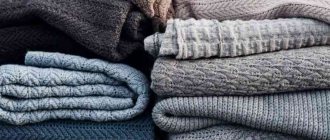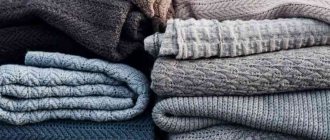Organza curtains are so popular today that they are found in almost every family. And this is no coincidence: the fabric is produced in a huge assortment. It comes in different colors, with patterns, etching, perforation, embroidery... Organza looks very attractive, and is quite affordable in price. This material does not require frequent washing, but you cannot do without it at all. How should you wash organza curtains to extend their service life? There are many nuances here, but compliance with them guarantees an excellent result.
Machine washable
Hand washing is ideal for organza tulle. But if you know how to wash it correctly in an automatic machine, you will significantly save your time. To ensure a successful wash, follow these simple rules:
- Remove the tulle from the curtain rod. Gently shake off the dust; it is better to do this outside or on the balcony.
- Soak the fabric, this step is important even when washing in a machine. Place the tulle in a bathtub or basin with lukewarm water to wash away most of the dirt and dust. Drain the water and lightly wring out the fabric.
- To prevent tulle from fraying, place it in a special mesh bag for washing delicate and thin items. If there is no bag, use a regular pillowcase. Place the product in the drum of the machine.
- Set the temperature to 30 °C, select the “delicate wash” mode. Turn off spin. The fabric is thin, so at high speeds its structure may change. Another important point: the higher the washing temperature, the more wrinkled the washed fabric will be.
- Pour a small amount of washing powder into the container. When washing organza, use liquid detergents. There is no need to add conditioner; this will cause the fabric to turn yellow when exposed to sunlight. If tulle needs to be bleached, use oxygen bleach. Do not use products containing chlorine.
- To thoroughly rinse the tulle, select the “extra rinse” mode. This will remove any remaining powder and help avoid streaks.
After washing, let the product hang over the bathtub or on the balcony to drain the water. Then hang the tulle in place. If creases are visible, iron the product. Set the temperature to the minimum; the “synthetic” or “silk” mode is ideal for ironing.
Using the washing machine
Modern automatic machines have a delicate wash mode. To wash organza in an automatic washing machine, you need to use a mild detergent without using a spin cycle, but first shake out the accumulated dust and soak in a soap solution.
Instructions:
- The fabric is placed in a delicates bag and placed in the drum.
- The temperature is set at 30 degrees, the spin is turned off. If it is not provided for in the car, then it is set to the minimum speed.
- An additional rinse mode is necessary to remove soap deposits on fabrics.
- It is advisable to fill the compartment with a special liquid product intended for washing organza.
- Conditioner is not used, as fabric soaked in it turns yellow in the sun.
- Oxygen-containing bleach helps remove stains.
Modern organza tulle can be immediately hung on the window after washing. All irregularities on it are straightened out under the influence of gravity.
Read about how to iron tulle in this article. Read about how to iron tulle in this article.
General washing rules
When working with thin fabric, you need to pay attention to the general washing rules. Is it possible to place organza in the drum of a washing machine and how not to damage it during intensive care.
- The water should be no higher than 35 degrees. Boiling water leaves dents and folds that are difficult to smooth out, even with steam.
- Detergents should only be gentle. Aggressive powders can damage fabric fibers.
- To carefully wash organza, you need to use a special bag. In it, it will not lose its shine and will not acquire a matte shade.
- Organza curtains can be machine washed, but only on a delicate cycle. It is better to use high-quality gels as a detergent.
- You can wash organza curtains by hand, but you should not rub or twist them. Such handling results in damage to the fibers. The fabric should only be slightly squeezed to remove any remaining moisture, or allowed to drain.
Expert opinion
Kristina Samokhina, experienced housewife.
Thin curtains can be hung in a damp state if they are not very wrinkled. It is advisable to use a steamer for ironing. It will prevent damage to the fibers, and the fabric will remain shiny.
How to iron after washing
As mentioned above, organza, curtains from which, due to their rigidity, keep their shape perfectly, is quite capricious to iron. Therefore, if it has dried out crumpled, you will have to work hard to smooth it out. But there is nothing supernatural in such a matter - something that any housewife could not cope with.
How to iron correctly
This device has gone through many stages of evolution, and does not lose its popularity, even when it comes to such delicate fabrics as organza. But you can’t do it without auxiliary equipment.
Tip: it is better to iron organza when it is still a little damp (but not wet!). If the tulle has already dried, moisten it with a very fine spray.
To iron an organza curtain, you will need two pieces of white cotton fabric. One should be placed under the tulle, and the second should be covered; it will act as a protective layer between the organza and the iron.
It is recommended to use cotton for these purposes, or, as a last resort, another material that does not have lint. Otherwise they will stick to the tulle.
It is also important that the fabric is white and without a pattern. After all, under the influence of temperature, it can be imprinted on organza.
Speaking of temperature: on the iron, as in the washing machine when working with organza, it should be between 30 and 40 degrees.
But even if all the conditions are met, remember: when you iron the tulle with an iron, do not hold it in one place, constantly move it over the fabric, otherwise the organza may go into waves.
How to steam organza curtains
Steaming - this option is always in demand when it is necessary to smooth out “problem” materials. It is also appropriate in the case of organza curtains. True, there is one thing here.
The steaming process will be inappropriate and very tedious if you need to iron organza tulle that is too wrinkled. From prolonged exposure to steam, which in this case is inevitable, the material may turn yellow.
If the folds and kinks in the tulle are small and there are few of them, use a steam generator, steamer or an iron with a vertical steam function. At the same time, keep the device at a distance of 15-20 cm from the fabric.
When steaming, the tulle should hang on the curtain rod. This way you will see all the problem areas and get the job done quickly.
Important: remember the difference between a steam generator and a steamer! The first produces dry steam, the second produces wet steam. So you need to use a steam generator to smooth out tulle that has not had time to dry completely. And the steamer uses dry material.
How to iron without an iron
Experienced housewives know how to iron organza without an iron or other equipment. It is enough to let them “hang” immediately after washing.
The tulle must be wet. As soon as you hang it on the curtain rod, immediately begin to carefully straighten the fabric with your hands and walk over the entire area of the curtain. Do not under any circumstances overstretch the material! It is enough just to run your palms over it from top to bottom with gentle pressure.
This method is the easiest, most convenient and not time-consuming. And there is also a bonus: the room where your curtain will dry and hang will be filled with freshness.
Organza is a beautiful, durable material, and if you care for it correctly, it will last. Wash and iron curtains made from this wonderful fabric in compliance with all the rules, and they will decorate your home for many years.
How to wash organza without ironing
The most important thing is not to wring out the fabric, so as not to iron it later to remove any creases that have formed. Dry flat. After the water has drained, the organza tulle, wet, is hung in a permanent place on the cornice. There it dries and takes its original form. If after drying the curtain is not smooth enough, you can eliminate the roughness directly by hanging it on the window using a steam generator at low temperature.
Watch the video - how you can wash organza so that it doesn’t wrinkle.
Rules for drying and ironing
Organza items should be dried away from heating radiators: on a clothesline outside or in the bathroom in an unwrung state. The water will drain randomly and the fabric will dry out. If there is a need to iron the product, then iron it with a slightly damp cloth using a low-temperature ironing setting (for silk). It is unacceptable to use steaming for organza. It is better to smooth out difficult areas through light cotton fabric (gauze).
In order for a veil item to remain of high quality for a long time, you must be able to properly wash organza fabric, dry it and iron it. With proper and systematic care, the product will delight you for many years.
Do I need to starch organza?
Impregnation of the material with a special composition, as a result of which the rigidity of the fabric increases, is called the starching process. This method not only increases the density of the product, but also increases wear resistance and resistance to stains. Usually, a specially prepared starch-based solution is used for this purpose, although there are ready-made household chemicals that simply need to be diluted according to the instructions. Whether to starch tulle curtains or not is up to each housewife to decide on her own, since with increasing rigidity the process of giving shape becomes more complicated, and the decorative effect of the tulle also decreases.
How to quickly starch organza:
- Rinsing curtains in a cold saline solution increases density without weighing down the fabric.
- The use of starch is undesirable due to the possible appearance of yellowness on the curtains.
- Ready-made products should be intended for delicate fabrics and should be used in clearly specified proportions.
What is prohibited to use when bleaching organza
- Organza is a tough fabric and very strong, however, the wrong product can quickly ruin it, so you need to choose products carefully;
- Organza should not be bleached using too aggressive means;
Therefore, when buying special bleaching products, you need to carefully read the composition, and it is important to study what fabrics the product is suitable for. If you cannot find a suitable remedy, then it is better to use folk remedies for whitening organza.
Wash by hand
Hand washing for organza is considered the most gentle procedure, as it avoids damage to the fabric.
Rules for washing organza products by hand
It is carried out in the following sequence:
- Pour warm water into the container at a temperature of no higher than 40 degrees.
- Add a neutral detergent, calculating that 1/2 tbsp is required. l. for 5 liters of water.
- Immerse the product completely in the solution and leave for 2 hours.
- Gently wash the fabric, lifting and lowering, without rubbing or twisting, using light squeezing movements.
Rinsing is carried out first in slightly warmed and then cool water. The movements are carried out without pressing. Lift the fabric and immediately place it on the rope to drain excess moisture.
How to wash organza by hand
For hand washing, pre-soaking, rinsing from dirty soapy water and washing directly in a freshly prepared solution with detergent are also done. During hand washing, it is convenient to examine each element of the product on your hands and treat stains with a stain remover. The characteristics (temperature, spin, detergents) are the same as for machine washing.
Organza fabric is very delicate and airy, so it cannot be rubbed, squeezed too hard, squeezed or twisted. Individual fibers can be damaged, and the veil will lose its impeccably elegant appearance. The product must be handled delicately: gently squeeze in a cleaning solution, lift, lower or turn. Instead of squeezing, it is better to allow the water or solution to drain freely. When pre-soaking the product, the direct washing time will take no more than 10 minutes.
Hand wash curtains
Hand washing is the best solution for light and delicate fabrics. It includes several stages and involves certain nuances. So, how to properly wash tulle by hand?
To begin, remove the tulle from the window and shake it to remove any settled dust. After this, you must first soak the curtain in warm water. This step is aimed at preparing the fabric for washing and making it easier to remove yellowing and stains that often appear on light-colored materials.
For soaking, you can use either your regular laundry detergent or table salt. It perfectly softens water and helps remove many serious contaminants. The soaking process lasts from 1.5 to 2 hours. Then you need to remove and rinse the tulle thoroughly in running water. Never use hot water on such fabrics: they will become hard and turn yellow quickly.
Next, you have to wash the tulle. Actually, washing consists of 2 stages.
First stage
Place in tulle in a bath or large vat of warm water. At what degrees should you wash? The optimal temperature is 30-35 degrees. In order to effectively wash a yellowed curtain, add apple cider vinegar at the rate of 1 tbsp. l. for 1 liter of water.
Now you need to choose your powder. The best option would be a gel for washing delicate fabrics. If you do not have a special product, use powder for automatic washing machines. The fact is that ordinary powder produces a lot of foam, which is difficult to get rid of during rinsing. And machine wash products practically do not form it.
After all the preparations, you should immediately start washing.
Choose a product that produces minimal foam.
Second phase
For the second stage, change the water and add a few drops of blue to it. The resulting solution should have a slight bluish tint. Dip the tulle into it and wash it again. Almost done! All that remains is to rinse the material in cool water, hang it up to drain and dry, and iron it thoroughly. The last point can be abandoned in the case of organza tulle. In this case, simply hang slightly damp curtains on the curtain rod. They will dry and smooth out on their own.
Whitening Recommendations
Do not use ammonia or hydrogen peroxide for bleaching as they are not suitable for synthetics and delicate fabrics. In this case, you need to use hot water with a temperature of 60 degrees, which is unacceptable for such materials. When washed this way, they become deformed, shrink and lose their attractive appearance. Hydrogen peroxide and ammonia are used for natural fabrics. They can bleach linen and cotton.
Use bleach with caution. Choose oxygen-containing compounds, as they have a gentle and gentle effect. At the same time, they wash quickly and efficiently. Do not wash organza using chlorine bleaches!
Do any whitening procedures in water with a temperature of up to 35 degrees. To keep the fabric white and fresh for a long time and acquire a beautiful shine, when rinsing, add two teaspoons of table vinegar per liter of water. After bleaching, do not iron the organza, but let the material dry and smooth out under natural conditions!
Do not twist or wring the organza too much. Be sure to read the label and follow the recommendations. It is important to wash, iron and dry your organza correctly to keep it white.
Subtleties of washing fine fabrics
The first thing you need to firmly understand is that you cannot put organza in the drum of a washing machine or in the bathtub for hand washing as soon as you remove the textiles from the window. Because dust particles accumulated on the surface of the fabric during washing, even in warm water, will become firmly embedded between the fibers. And then she will not be able to return beauty and freshness.
Therefore, the first thing to do before washing organza is to shake it out thoroughly (on the street or, in extreme cases, on the balcony, so as not to “enrich” the room with dust). But it’s still too early to wash the curtains. They should be rinsed several times in cool water to completely remove the dusty deposits. Only after this the organza window decoration is ready for the main wash.
It is important to consider a few more points before washing.
- You need to inspect the canvas for dirty and greasy stains. If there are any, the curtain should be soaked for about an hour in warm water with detergent. If there is dirt, you can add a little soda or salt to the water, and dishwashing detergent will help remove the grease.
- In no case should you bleach organza curtains before they are washed: it will not be possible to adequately assess the degree of lost whiteness, and the substances added for bleaching eat into the fabric on top of the dust that has not been washed off. Will such a curtain be white? Therefore, they wash them first, then, if necessary, return the curtains to their whiteness.
- You can bleach curtains or tulle made of this fabric after washing by rinsing them in a salt solution or in water with the addition of a few drops of blue or a small amount of ammonia.
- Organza does not like hot water - it can cause the delicate fabric to bubble, turn yellow and become deformed. Therefore, the water temperature should not exceed 35 degrees.
- For washing, you should choose substances with minimal foaming (gels or powders for automatic washing machines), since the foam will then be quite difficult to wash, and its remains will certainly appear as unsightly white stains. Even for hand washing, it is better to take liquid powder.
- Chlorine bleaches for this fabric are contraindicated. They will not provide the required whiteness (rather, on the contrary, they will make the curtains even more yellow), and they will damage the structure of the fibers.
Advice
When washing with your hands, wear rubber gloves: washing powders for automatic machines are quite aggressive and often cause allergic reactions on the skin of your hands.
Handwash
If you are hesitant to wash your organza in the washing machine, it is very easy to do it by hand. Consider the process of hand washing.
The initial stage is pre-wash. Fill the bathtub with warm water and place the tulle in it. The temperature should not exceed 35 ° C so that dust does not stick to the fibers and the fabric does not acquire a gray tint. Add a few cups of salt, laundry detergent or liquid laundry detergent. If you are washing tulle that has been hanging in the kitchen, prepare the following soaking mixture: baking soda, table salt and liquid dishwashing detergent. This will help to efficiently clean grease stains and soot from the product.
Leave the curtains soaked for several hours to allow the cleaning products to absorb thoroughly. Then rinse the product in plenty of lukewarm water.
After soaking, begin the washing process. Add liquid detergent or laundry detergent to a bath of warm water. Beat it into foam and only then lower the tulle. For 10 liters of water add 1 tbsp. l. detergent. Remember that you cannot rub or twist the product too much, as this will damage its structure. When washing, use light, slightly squeezing movements.
A very important step is rinsing. It is necessary to rinse the product thoroughly several times so that no detergent remains.
Products made from organza should not be rubbed or twisted too much.
Hang the slightly wrung out organza over the bathtub to drain off any remaining water. Then secure the tulle to the cornice until it dries completely. If the fabric looks wrinkled, iron it with a lukewarm iron.
Traditional methods of whitening organza
As a cleaning agent for washing and bleaching organza at home, you can use products available in the kitchen at hand, which will not lead to allergic reactions and unnecessary expenses of the family budget.
Salt
You can wash and bleach white organza without using household chemicals using table salt. To do this, you need to prepare a cleaning solution by mixing 3 tablespoons of salt in 10 liters of warm water, then soak the curtains and drapes in it for several hours. After soaking, you must wash them by hand or in a washing machine at a temperature not exceeding 30 degrees and rinse the products thoroughly in clean, cool water.
Zelenka
Despite the seeming absurdity of the expression, tulle and organza curtains can be bleached with ordinary brilliant green, available in every medicine cabinet. To do this you need to do the following:
- Dissolve brilliant green solution (10 drops) in a glass of warm water.
- After a sediment forms at the bottom of the glass, stir the solution again until completely dissolved.
- Pour the prepared solution into a bowl of warm water, stir and place the curtains and curtains to be bleached.
- Soak the product for 5 minutes, turning occasionally.
- After the allotted time, so as not to iron the organza, hang the curtains in a vertical position, allowing them to drain and dry on their own.
Blue
You can bleach organza curtains using bluing as follows:
- Prepare a solution from 1 cap of blue and 10 liters of warm water no higher than 30 degrees.
- If there is sediment in the solution, stir it again until completely dissolved.
- Immerse the organza in the solution, remove it and immerse it in a second basin with clean, cool water.
- Repeat the action 5-6 times.
- Rinse and hang to dry.
It is worth noting! Organza is bleached after the main wash. When rinsing curtains in the washing machine so that they are white, after drying, you can pour one capful of blue into the fabric softener or fabric softener compartment.
Ammonia and peroxide
To bleach curtains and tulle with ammonia and peroxide, it is worth considering three methods:
- Express. Ammonia (1 tablespoon) and hydrogen peroxide (2 tablespoons) should be dissolved in a bowl of warm water. Stir the solution thoroughly, then immerse the product in it for 30 minutes, turning it over periodically. Remove the curtain, rinse thoroughly and hang it upright, allowing the water to drain.
- All night long. Pour a bottle of ammonia into a bowl of warm water, stir thoroughly, immerse the curtain and leave it overnight. In the morning, rinse in cool water and leave in an upright position without squeezing.
- In the washing machine. Along with the washing powder, add 20 ml of peroxide to the tray. In this case, it is recommended to set the “Delicate washing mode” on the washing machine.
Starch
After the main wash, organza should be placed in a special solution to turn it white. To do this, you need to dissolve 250 grams of potato starch in a basin with warm water no higher than 30 degrees and immerse the curtains in the solution for 5-6 hours. After the time has passed, it is necessary to hang it vertically, allowing the main water to drain, and then return the product to the curtain. Once dry, the starch will give the curtains a distinct relief shape.
Baking soda
You can bleach gray organza that has become gray over time using baking soda, which can remove even old stains. To do this, dilute 100 grams of washing powder until completely dissolved in a bowl of warm water and add a couple of tablespoons of soda. Soak the curtains for half an hour in the prepared solution, then wash and rinse by hand or in an automatic washing machine.
Potassium permangantsovka
You can remove yellowness from organza using ordinary potassium permanganate. To do this you need to do the following:
- Dissolve potassium permanganate in water until the solution turns slightly pinkish.
- Thoroughly rub the organza with soap and place in the resulting solution for 45-60 minutes.
- Rinse the product and hang it to dry.
Laundry soap
To bleach organza tulle with laundry soap, first grate it, pour it into a pan and add water. Then the pan must be placed on the fire and brought to a boil. Add cool water and soak the tulle in the solution overnight, and in the morning wash and rinse the product.
Lemon acid
Light organza curtains without a pattern can be bleached with ordinary citric acid. To do this, the fabric should first be wetted and rubbed with laundry soap, then soaked in warm water for half an hour. Add 5-7 tablespoons of acid and after half an hour, rinse thoroughly in cool, clean water.
Dishwashing liquid
For curtains hanging in the kitchen, using dishwashing gel will help. In a bucket or basin, dissolve a small amount of dishwashing liquid and a couple of tablespoons of baking soda in water. Soak the curtains for a couple of hours, then rinse thoroughly.
Cooking curtains
To bleach tulle using this method, do the following:
- Grate soap into a large saucepan of water or add washing powder.
- After complete dissolution, immerse the organza in the solution and put on fire.
- Bring to a boil and cook for an hour.
- Rinse the tulle and hang to dry.
Important! You cannot cook synthetic curtains.
Hand wash
Organza curtains should be soaked and washed using products with minimal foaming. They remove any type of stain and are rinsable from fabric. These include liquid products intended for delicate washing. The use of chlorine-based bleaches is strictly prohibited. You should also not use aggressive detergents. The average powder consumption is approximately 1 tbsp. l. for 10 liters of water.
Pre-soaking helps get rid of stubborn stains. Use a few cups of table salt or baking soda to soften the water and dissolve stains, and a little vinegar to add shine. The tulle is soaked for three hours in warm salt water with the addition of a small amount of washing powder. Then rinse with cool water. Read about other ways to bleach tulle here.
Soaking kitchen curtains in water with some dishwashing liquid helps remove stubborn grease stains.
The basin is filled with water at a temperature of 40 degrees, a gentle detergent is added and whipped to a thick foam. The fabric is placed in a soap solution and washed with light movements. Rubbing dirt is unacceptable; you need to carefully wash the organza.
At the end of washing, you need to hang the fabric over the bathtub without squeezing or twisting it, fill a basin with clean water and rinse, changing the water several times. At the end of the procedure, you can add a small amount of blue to the water to give the fabric a new effect.
Handwash
Not everyone trusts the capabilities of modern technology and prefers the manual process of caring for delicate fabrics. How to wash organza tulle without a machine, what you need to do to clean the curtains and maintain their original appearance. There are several simple rules that are recommended to be followed. The fabric is easy to wash, but powder alone will not be enough without preliminary preparation.
Soak
How to wash organza curtains by hand if there are stains on them and yellowness has appeared. The usual soaking comes to the rescue. Pour several glasses of salt and a little powder into the bath. The temperature should not exceed 30 degrees. The curtains can lie in this solution for several hours, after which they must be rinsed with plenty of cold water. Such preparatory steps will remove yellowness from white fabric.
How to wash kitchen linen with greasy stains and soot. You need to pour dishwashing detergent into the soaking water and add a little baking soda. They allow you to dissolve fat and get rid of sticky soot. The products should remain in the solution for several hours to make it easier to remove contamination. Before washing, curtains must be rinsed well.
Wash
To properly wash organza tulle by hand, you do not need to rub or twist it. Thin, delicate fabric cannot tolerate such roughness. Curtains are placed in water at a temperature of no more than forty degrees. The powder must first be dissolved in it so that its large particles do not adversely affect the fabric. In the manual process, as well as in the machine process, it is recommended to use gel.
The tulle has already been soaked, but to make it shiny, it is recommended to add a little vinegar to the water. In this solution, you need to wash the tulle with light squeezing movements, as if you were holding a fragile snowball in your hands, and not a piece of fabric.
Rinsing
If the machine does everything unnoticed, then when washing by hand you will have to go through all the stages yourself. The tulle is laid out in a basin and flows around it, during which time the bath is filled. The rinse water should be cool, but without sudden temperature changes. When the curtains flow around, they can be placed in the bathroom. It is necessary to rinse until the residue from the detergent is gone. If you add a little blue to the last water, the tulle will acquire its original appearance, as when purchased. Once the curtains have flowed around, they can be hung on the curtain rod.
Whitening organza items
Most often, graying appears on kitchen curtains or in a smoker's room. Organza is a fabric that captures surrounding odors and substances. So if the curtains have lost their whiteness, don't worry. It's easy to wash organza until it turns white. Soak it for 1 hour in a solution of water and soda at the rate of 10 liters of water per 500 g of soda. This will help remove dust, remove all deposits and even remove greasy stains. After soaking (before washing), it is recommended to rinse the product in clean water.
Expert opinion
Irina Kovtun
Head of a cleaning company
Dark marks from white organza are easily removed by a mixture of alcohol and turpentine (1 tbsp per 5 liters of water).
Previously, potassium cobalt silicate was also used for bleaching. Today this substance is not so available, but it can be replaced with a few drops of blue ink. Add them to the water during the final rinse. But be careful, the ink itself does not bleach, it simply adds clarity to the fabric.
Important! It is better to remove stains in dry cleaners or consult with specialists so as not to damage the delicate fabric.
How to wash - in a machine or by hand?
In order to decide which way is best to wash a particular organza product at home, you need to have an idea of:
- fabric composition;
- type of staining;
- organza form;
- type of decoration or decoration method, if present;
- degree and composition of pollution;
- the presence of additional non-removable parts in the product.
Organza fabric varies in composition.
Most often it is made from synthetic threads woven from polymer fibers. Sometimes you can find organza made of silk, viscose, or a mixture of threads of different compositions. The fabric manufacturer is required to indicate the exact composition on the label - this information makes care easier. The housewife needs to know the composition of the fabric in order to choose the right washing mode and care products for an organza product.
According to the type of dyeing, organza can be white, colored or with a printed pattern. It can be decorated with applique, embroidery, etching or decorated with laser cutting or perforation.
Most often, organza products, such as curtains, clothes, accessories, can be machine washed. Exceptions include products containing additional non-removable rigid parts. Stage costumes and other complex products that include organza are washed by hand so as not to damage them.
When choosing a detergent, preference is given to liquid powder and gel. For hand washing, the simplest detergent is a warm solution of baby soap. Liquid products act quickly on the fabric, rinse well and do not leave streaks. It is advisable not to use dry synthetic powder products. As a rule, after washing they leave marks on the fabric.
Among the universal options, suitable for both machine washing and hand washing, gels from the Synergetic brand are in demand.
A little about organza
Organza is a fabric that is created from silk, viscose and polyester.
Thanks to this, a tough and strong fabric was created that is pleasant to the touch and almost weightless. It was created in China and was brought to Europe at the end of the 18th century. This fabric quickly became popular, despite the fact that it was very expensive. Today organza is also very popular, but more accessible.
This fabric is mainly used for:
- Sewing wedding and evening dresses;
- Sewing curtains and tulle;
- Sewing decorations for banquet halls and gift packaging;
- Handicrafts.
The use of organza in these areas is due to the fact that this fabric has the following properties:
- It is indestructible;
- It has very high light transmittance;
- Very durable;
- Resistant to organic solvents;
- Retains its original shape for a long time. Organza retains its shape and size throughout its entire service life, but it will change if you wash it incorrectly (wash at high temperature, wring out) and dry the item;
- It is durable and with proper care, it will retain its original appearance for a long time.
Thanks to this, organza products are very popular, and they are found in almost every home. However, many women do not care for the fabric correctly, which is why it quickly loses its beautiful appearance and darkens.
Is it possible to wash organza curtains in an automatic washing machine?
Despite its thinness and lightness, organza tolerates machine washing well. To preserve the properties of the fabric, you must follow simple rules when choosing the operating mode of the washing machine, the appropriate detergent and the number of spin speeds. A special mesh laundry bag will help make the task easier and reduce the risk of organza damage. An important condition is the absence of the slightest damage and the processing of the edges of the curtains. You can find out how to process the edge of organza in your nearest studio or in specialized literature.
Important! Organza should not be washed together with other fabrics, and the fabric should also be sorted by color. This will avoid staining the material, the appearance of streaks and disruption of the structure.
Selecting the optimal mode
Modern washing machines allow you to select the desired washing mode suitable for various fabrics. The sequence of actions depends on the degree of contamination of the tulle curtains. How to properly machine wash organza:
- You can load curtains into the drum without pre-soaking if the fabric only needs light cleaning and there are no stains or heavy dirt.
- Before washing organza kitchen curtains, you should first rinse them in cool water and remove fat deposits.
The delicate wash program in an automatic washing machine requires a low temperature, gentle handling of the product and a low spin speed. Organza after this treatment looks fresh and does not require further processing. After washing, the curtains can be immediately hung on the curtain rod.
Setting the appropriate temperature
Organza curtains do not withstand high temperatures well, losing their elasticity, lightness and acquiring a dirty gray tint. Using hot water causes dirt and dust to literally stick to the fibers of the fabric, complicating the cleaning process and making washing ineffective. In the delicate mode in the washing machine, a temperature of 30-35 degrees is used, it is in this range that it is possible to preserve the properties of organza and wash the curtains without deformation or loss of appearance.
Selection of detergent
Organza is a delicate fabric and requires a picky choice of detergent. Powders have good cleaning properties, but lead to increased foaming. It is difficult to wash out the remaining foam from the spaces between the tulle fibers, so such curtains should be washed using liquid gels. The amount of liquid detergent depends on the brand, so before washing organza in the machine, you should carefully study the instructions.
Organza detergents
When choosing types of detergents for curtains, pay attention to the powder, which produces a small amount of foam. This makes it easier to remove while rinsing.
But to ensure that you achieve the predicted result, it is recommended to give preference to gel-based products. They do not leave streaks and are easily washed out of the fibers.
It is not advisable to use conditioner when washing organza, so as not to cause yellowness to appear on the fabric during drying.
When purchasing washing gel, pay attention to the instructions.
This will allow you to choose the most suitable brand depending on the characteristics of the material:
- Among the universal options suitable for hand and machine washing, the Synergetic brand is in demand. This is a hypoallergenic biodegradable gel.
- Organic People gel is well suited for delicate fabrics. It allows you to avoid shrinkage of organza with embroidery and a predominance of silk fibers. Products from the Sion and Burti Wolle & Seide brands cope with this role.
- To safely wash colored tulle, use Levrana gel, which contains coconut plant surfactants, glucose and a complex of enzymes. These substances allow you to quickly get rid of dirt while maintaining the richness of the colors. For this purpose, effective varieties of the brands Freshbubble, Cotico, Meine Liebe, Ariel Color, Losk Color are used.
Meine Liebe laundry detergent
Margot gel will help avoid deformation of synthetics when hand washing.
Organza for curtains - types and characteristics
Organza is usually made from synthetic threads or a combination of synthetics and natural fibers. This fabric may include:
- polyester threads - thin, durable, specially cut to give them a spectacular shine;
- viscose fibers, made artificially from wood, are soft and hygroscopic;
- silk threads are smooth, durable and beautiful, used in the manufacture of the most expensive fabrics.
The canvases can be smooth, monochromatic, with color tints, patterns, embroidery, etching, or printing. To maintain their appearance for a long time, all types of organza require regular and proper care.











